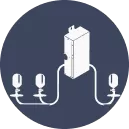Lighting plays a vital role in modern agriculture, particularly in indoor farming, greenhouses, and controlled environment agriculture (CEA). Whether you're growing vegetables, herbs, or flowers, choosing the right lighting can significantly impact plant health, yield, and energy efficiency. In this category, you’ll find advanced agricultural lighting systems tailored to meet the needs of every grower—from small-scale operations to commercial greenhouse farms.
This guide explores the importance of lighting in agriculture, the different types of grow lights available, key benefits, and how to select the best lighting solutions for your crops.
Why Lighting Matters in Agriculture
Proper lighting is essential for photosynthesis, the process by which plants convert light energy into chemical energy. In outdoor farming, sunlight is the primary source of light. However, in greenhouses and indoor farming setups, supplemental lighting ensures plants receive consistent and adequate light levels throughout their growth cycle.
Agricultural lighting helps:
- Extend daylight hours during shorter seasons
- Improve crop yields and quality
- Support seedling and vegetative growth
- Stimulate flowering and fruit production
- Reduce crop cycles for faster harvests
Without optimized lighting, plants may become leggy, underdeveloped, or fail to produce flowers and fruits.
Types of Agricultural Lighting
Choosing the right grow light depends on your crop type, growth stage, setup, and energy efficiency needs. Here are the main types of agricultural lighting systems available:
1. LED Grow Lights
LED (Light Emitting Diode) grow lights are among the most popular options due to their energy efficiency, low heat output, and customizable light spectrum. Benefits include:
- Long lifespan (up to 50,000+ hours)
- Tunable spectrum for different growth stages
- Minimal heat generation, reducing HVAC load
- Lower energy costs over time
LED grow lights are ideal for vertical farming, hydroponics, and commercial greenhouse installations.
2. High-Pressure Sodium (HPS) Lights
HPS lights emit a warm, yellow-orange spectrum ideal for flowering and fruiting stages. They’ve been widely used in greenhouses for decades due to their high light intensity.
Pros:
- Excellent for late-stage plant development
- Affordable initial investment
- High penetration for larger plants
Cons:
- Higher heat output
- Less efficient than LEDs
- Requires proper ventilation and cooling
3. Metal Halide (MH) Lights
Metal Halide lights emit a cool, blue-white spectrum, which is perfect for vegetative growth and seedling development.
Advantages:
- Encourages leafy growth and compact plants
- Often used in early growth stages before switching to HPS
Drawbacks:
- Shorter lifespan than LEDs
- Higher electricity consumption
4. Fluorescent Grow Lights (CFL & T5)
Fluorescent lights are suitable for small grow operations, propagation trays, and seed starting.
Features:
- Low heat output
- Economical for beginners
- Best for low-light plants and early-stage growth
Limitations:
- Lower intensity not suitable for full-cycle growth
- Shorter lifespan compared to LED
Choosing the Best Grow Light for Your Farm
When selecting a lighting solution, consider the following factors:
- Crop type and growth stage
- Light spectrum (full-spectrum vs. targeted)
- Intensity and PPFD (Photosynthetic Photon Flux Density)
- Coverage area
- Installation setup (indoor, vertical, or greenhouse)
- Energy efficiency and cost
- Cooling and ventilation requirements
LEDs are generally the best long-term investment for most growers due to their versatility, spectrum control, and operational savings.




